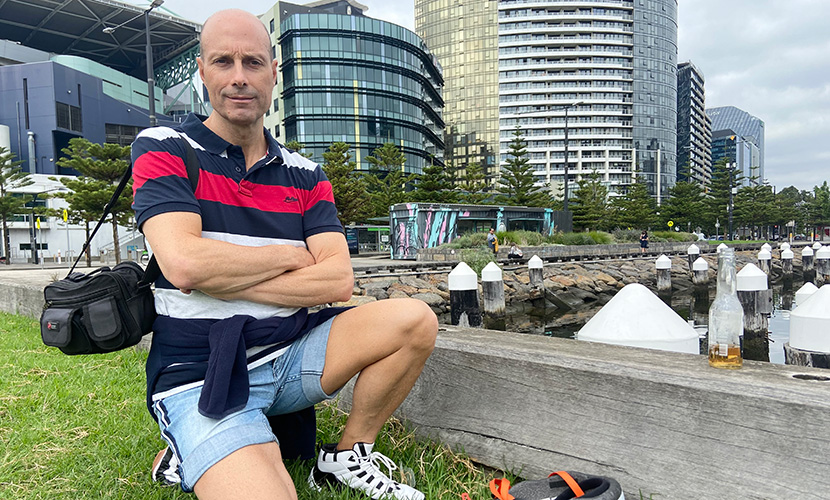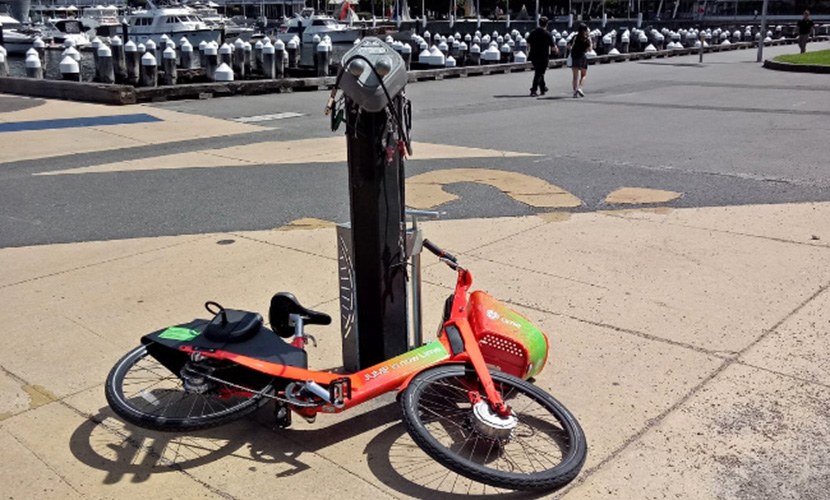E-bike and e-scooters debate re-emerges after misuse sparks calls for education
The e-bike and e-scooter debate has again divided community opinion after a resident spoke of their frustration of seeing the electric-powered transport devices dumped across the Docklands precinct.
“Not having docking bases, all those types of vehicles are abandoned everywhere, sea and Yarra River included, as also confirmed by other citizens,” Docklands resident Pierfrancesco Iarussi said after posting a picture to Facebook of a discarded bike near Victoria Harbour.
“You can see them almost everywhere. Around 10 days ago there was a scooter in the water more or less in front of 7Melbourne.”
“In my opinion, it makes beautiful Melbourne look dirty and messy.”
Mr Iarussi’s concerns come after the failed oBike hire scheme in 2018 saw yellow bicycles abandoned in rivers and up trees, while police recently launched a crackdown on e-scooter misuse after users caused havoc on roads and footpaths.
He questioned whether docking stations could be provided for bikes and scooters, saying “can this service be managed as everything else to hire, from a car, to a pair of roller blades?”
Lime is operating the electric share bike [e-bike trial] in the City of Melbourne, Yarra, and Port Phillip after a temporary pause due to the pandemic.
According to the City of Melbourne, e-bikes will encourage cycling in the city and reduce transport emissions and congestion with Lime being responsible for all aspects of the operation of the service.
Under the rules, e-bikes should be locked to public bicycle racks where available, however, to retain access to parking for regular bicycles, share bicycles should “not completely occupy any bank of public bicycle racks.”
Otherwise, e-bikes must be parked in an upright position and not placed on footpaths that are less than 1.5 metres or within 1.5 metres of buildings.
They must also not be placed where they could obstruct peak pedestrian flows or otherwise pose a safety hazard.
City of Melbourne councillor and Docklands resident Jamal Hakim said he so far hadn’t seen an issue with the operation of e-bikes and e-scooters but encouraged residents with any concerns to contact the council.
“It’s really important that we put all that feedback together so it’s a mode of transport that’s successful,” he said.
“I think most people who are riding e-scooters are doing the right thing … but it’s really important for us to understand where it’s working and where it’s not working,” he said.
I’ve heard lots from residents in Docklands say how fantastic the e-scooters have been for mobility around Docklands.
“We’ve got such an expansive space in Docklands – I spoke to residents on NewQuay recently who shared with me how e-scooters have meant they are able to go from NewQuay and Victoria Harbour so much more quickly.”
The orange and green e-scooter trail was rolled out in the City of Melbourne and surrounds from February 1 which is being operated by Neuron Mobility.
A company spokesperson said it had been “well-received by the community and are adding an environmentally friendly transport option to the city.”
“Neuron’s e-scooters have been embraced by Melbourne locals and visitors, we’ve had an amazingly busy start to the trial with over 650,000 kilometres travelled so far, and the overwhelming majority of people are riding responsibly,” the spokesperson said.
“Neuron e-scooters are fitted with GPS and are controlled by geofencing, so they cannot be ridden out of the riding area, or they lose power entirely.”
“We have worked closely with the City of Melbourne to set up our operating zone. For example, there is a total no parking zone around the Yarra River.”
The Neuron Mobility spokesperson added its “geofencing” technology also controls speed in some areas, and the e-scooters also have a topple detection feature, “which means that if they are left on their side, our ground team gets an alert and then moves to reposition it safely.”
“Our e-scooters are also fitted with registration plates so members of the public can report any issue, like an incorrectly parked e-scooter for instance, to our customer support team, via our app or by phone and email - the details can be found on our website and on our e-scooters.”
A Docklands Representative (DRG) spokesperson said e-scooters, e-bikes, and segways (a two-wheeled personal transporter) were widely cited as “the solution” to the transport congestion.
“But if they are to be a legitimate part of our system, then they have to be treated as such, meaning that they have to be formally integrated into our transport infrastructure, starting with education about the rules, allocation of space [away from pedestrians] and good ‘end-of-trip’ facilities,” the DRG spokesperson said.
“Currently these micro mobility vehicles have just been ‘let loose’ under the pretext of a ‘trial’. There are already a lot of learnings from other Australian cities that Melbourne has failed to take on board.”
Robert Dunstone, the building manager of Harbour One apartments at NewQuay, said he found scooters dumped at the entrance of the building on a daily basis, which posed a safety hazard for residents if they had to evacuate.
Mr Dunstone said he was also troubled by the sight of drug dealers riding around on e-scooters to sell to people sitting in cars.
“They come around on their e-scooters with bum bags; cars pull up and you can actually see them do the deals through the window,” he said.
“I will get them on footage, it happens quite a lot. You see it especially out on Aquitania Way.”
Mr Dunstone said mini zip-lock bags containing what appeared to be a crystal-like substance were also being discarded on footpaths.
“In the past six months it’s just gone downhill fast.” •
Caption: Pierfrancesco Larussi is concerned about e-bikes and e-scooters being abandoned around Docklands.

New park to revitalise historic maritime precinct in Docklands








 Download the Latest Edition
Download the Latest Edition